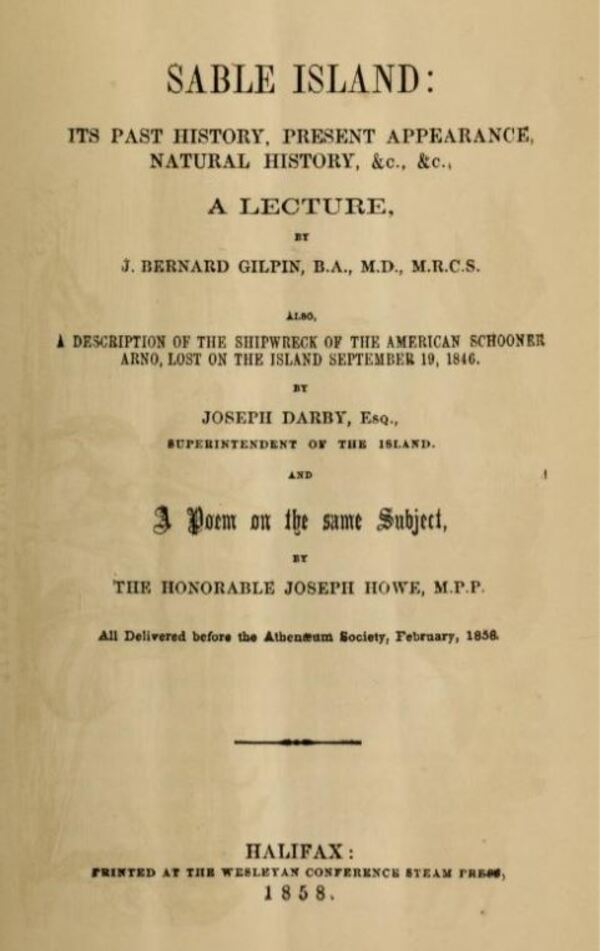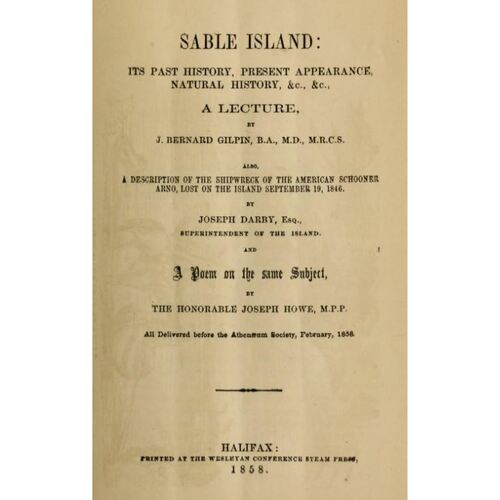
Source: Link
GILPIN, JOHN BERNARD, physician, surgeon, naturalist, author, and artist; b. 4 Sept. 1810 in Newport, R.I., fourth child of John Bernard Gilpin and his second wife, Mary Elizabeth Miller; m. 13 Aug. 1846 Charlotte Smith (d. 1851) in Digby, N.S., and they had two sons; d. 12 March 1892 in Annapolis Royal, N.S.
John Bernard Gilpin’s father, who had come to Philadelphia from England in 1783, held the office of British consul at Newport, R.I., from 1802 to 1832. His son was prepared for college there and took his bachelor of arts degree at Trinity College in Hartford, Conn., in 1831. After a one-year apprenticeship in the office of Dr T. C. Gunn in Newport, he entered the University of Pennsylvania, where he obtained his md in 1834 with a graduating essay entitled “Old age.” His whereabouts for the next few years is unknown, but in January 1838 he is recorded as practising medicine in Annapolis Royal. Gilpin’s father had retired there in the spring of 1833 to be near two sons of his first marriage, Edwin and Alfred Gilpin, both Anglican clergymen. Annapolis Royal in 1838 was a town with slightly more than one thousand inhabitants and was served by a single doctor, Robert Leslie. Four other medical practitioners met the needs of the farming districts surrounding the town.
In 1845 Gilpin travelled to London, England, where the following January he passed the examination qualifying him as a member of the Royal College of Surgeons of England. He returned to Nova Scotia early in 1846 and became one of only five doctors in the province who were officially qualified as both physicians and surgeons. Following his marriage later that year, Gilpin moved to Halifax and set up practice on Barrington Street. In 1847 he served as assistant health officer for the port of Pictou, helping with the serious outbreak of typhus there. A member of the Medical Society of Halifax, he was involved in the reorganization of that body as the Medical Society of Nova Scotia in 1854.
Although Gilpin’s contributions to the medical profession in Nova Scotia were important, it is as a naturalist that he is chiefly remembered today. He had probably moved to Halifax in order to be close to others with similar literary and scientific interests. He remained a widower after his wife’s early death in 1851, and during the next 40 years he became deeply engrossed in the study of the fauna of Nova Scotia. A founder of the Nova Scotian Institute of Natural Science (later the Nova Scotian Institute of Science), on 2 Feb. 1863 he presented the first paper read before the society, on the common herring. As a member and president (1873–78) of this organization Gilpin gained a solid reputation in Canada and the United States in the latter half of the 19th century as a naturalist and zoologist. Over 20 years he gave a total of 34 papers, which were published in the transactions of the institute. His subject-matter included birds, fishes, seals, walruses, moose, beavers, serpents, and fossils, with a lengthy series being devoted to the mammalia of Nova Scotia. He also wrote on the Stone Age and on the Indians of the province. His lecture Sable Island: its past history, present appearance, natural history, &c., &c. was published in Halifax in 1858. The pamphlet also included a description by Joseph Darby of the shipwreck of the schooner Arno in 1846 and a poem by Joseph Howe*.
Gilpin’s papers were frequently illustrated with his own drawings. In 1892 Martin Murphy, president of the Nova Scotian Institute of Science, observed, “The museum has been served by his brush as well as by his pen, for he possessed the unusual accomplishment of an accurate and artistic reproduction in colors of any subject being treated of in his papers.” An obituary in the Halifax Herald praised “his spirited sketches of the wild, typical ponies of Sable Island,” which “still bear testimony to his skill in portraying animal life.”
A foundation fellow of the Royal Society of Canada, established in 1882 [see Sir John William Dawson], Gilpin retired in that year to Annapolis Royal, where he lived for the remainder of his life. Following his death in 1892, he was buried in the old parish cemetery there beside his wife and infant son, Bernard.
Tributes to Gilpin recognized his contribution to the natural history of Nova Scotia. Harry Piers, in a series of profiles of past presidents of the Nova Scotian Institute of Science, described him as “probably the best student of the higher animals we have had. He possessed a racey, picturesque and attractive literary style, coupled with close accuracy in his statements and determinations. Furthermore he was a good draughtsman, wielding a ready pencil and brush, which assisted in illustrating his lectures.” In 1910 Dr Donald Alexander Campbell observed in the Maritime Medical News that “he was constantly doing his utmost to assist and encourage the study of Natural History in the Province, and was frequently consulted by Professor [Spencer Fullerton] Baird of the Smithsonian Institute, as to the determination of new or doubtful species of fish and as to their migrations in these northern waters.”
A list of the papers which John Bernard Gilpin published in Nova Scotian Institute of Natural Science, Proc. and Trans. (Halifax), 1 (1863–66)–5 (1879–82), is available in D. A. Campbell, “Some Nova Scotia physicians and their contributions to natural science,” Maritime Medical News (Halifax), 22 (1910): 184–85. Some of his drawings are now in the collection of the Nova Scotia Museum (Halifax).
PANS, MG 1, 329, esp. nos.1, 27; 717, no.53; MG 4, 23, reg. of marriages, 13 Aug. 1846; RG1, 175: 471; RG 25, C, 10, no.1: 192. St Paul’s Anglican Church (Halifax), Reg. of baptisms, 13 Aug. 1847, 3 Aug. 1849 (mfm. at PANS). Univ. of Pa. Arch. (Philadelphia), Medical school records, esp. index to medical matriculants, 1834. Nova Scotian Institute of Science, Proc. and Trans., 6 (1883–86): 158; 8 (1890–94): xlvii-xlviii; 10 (1898–1902), photograph facing p.xxxv; 13 (1910–14): lxxxii-lxxxiv. RSC Trans., 1st ser., 1 (1882–83), proc.: iv, xxvi. Halifax Herald, 22 March 1892. Novascotian, 10 March 1851. Belcher’s farmer’s almanack, 1845. Catalogue of the alumni of the Medical Department of the University of Pennsylvania, 1765–1877 (Philadelphia, 1877). Cunnabell’s N.-S. almanac, 1851: 76. Dictionary of American medical biography . . . , ed. H. A. Kelly and W. L. Burrage (New York, 1928). N.S. directory, 1871. Eaton, Hist. of Kings County. D. A. Campbell, “History of the Medical Society of Nova Scotia,” Maritime Medical News, 15 (1903): 540. Harry Piers, “Artists in Nova Scotia,” N.S. Hist. Soc., Coll., 18 (1914): 153.
Cite This Article
Allan E. Marble, “GILPIN, JOHN BERNARD,” in Dictionary of Canadian Biography, vol. 12, University of Toronto/Université Laval, 2003–, accessed January 14, 2026, https://www.biographi.ca/en/bio/gilpin_john_bernard_12E.html.
The citation above shows the format for footnotes and endnotes according to the Chicago manual of style (16th edition). Information to be used in other citation formats:
| Permalink: | https://www.biographi.ca/en/bio/gilpin_john_bernard_12E.html |
| Author of Article: | Allan E. Marble |
| Title of Article: | GILPIN, JOHN BERNARD |
| Publication Name: | Dictionary of Canadian Biography, vol. 12 |
| Publisher: | University of Toronto/Université Laval |
| Year of publication: | 1990 |
| Year of revision: | 1990 |
| Access Date: | January 14, 2026 |



